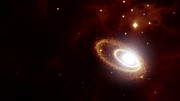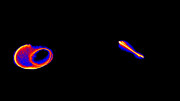Supermassive black hole with torn-apart star (artist’s impression)
Videos

Spinning supermassive black hole rips star apart (artist’s impression)
Supermassive black hole rips star apart (simulation)
An extraordinarily brilliant point of light seen in a distant galaxy, and dubbed ASASSN-15lh, was thought to be the brightest supernova ever seen. But new observations from several observatories, including ESO, have now cast doubt on this classification. Instead, a group of astronomers propose that the source was an even more extreme and very rare event — a rapidly spinning black hole ripping apart a passing star that came too close.
Notes
[1] As well as the data from ESO’s Very Large Telescope, the New Technology Telescope and the NASA/ESA Hubble Space Telescope the team used observations from NASA’s Swift telescope, the Las Cumbres Observatory Global Telescope (LCOGT), the Australia Telescope Compact Array, ESA’s XMM-Newton, the Wide-Field Spectrograph (WiFeS) and the Magellan Telescope.
More Information
This research was presented in a paper entitled “The Superluminous Transient ASASSN-15lh as a Tidal Disruption Event from a Kerr Black Hole”, by G. Leloudas et al. to appear in the new Nature Astronomy magazine.
ESO telescopes help reinterpret brilliant explosion
An extraordinarily brilliant point of light seen in a distant galaxy, and dubbed ASASSN-15lh, was thought to be the brightest supernova ever seen. But new observations from several observatories, including ESO, have now cast doubt on this classification. Instead, a group of astronomers propose that the source was an even more extreme and very rare event — a rapidly spinning black hole ripping apart a passing star that came too close.
In 2015, the All Sky Automated Survey for SuperNovae (ASAS-SN) detected an event, named ASASSN-15lh, that was recorded as the brightest supernova
ever — and categorised as a superluminous supernova, the explosion of
an extremely massive star at the end of its life. It was twice as bright
as the previous record holder, and at its peak was 20 times brighter
than the total light output of the entire Milky Way.
An international team, led by Giorgos Leloudas at the Weizmann Institute of Science, Israel, and the Dark Cosmology Centre,
Denmark, has now made additional observations of the distant galaxy,
about 4 billion light-years from Earth, where the explosion took place
and they have proposed a new explanation for this extraordinary event.
“We observed the source for 10 months following the
event and have concluded that the explanation is unlikely to lie with an
extraordinarily bright supernova. Our results indicate that the event
was probably caused by a rapidly spinning supermassive black hole as it
destroyed a low-mass star,” explains Leloudas.
In this scenario, the extreme gravitational forces of a supermassive black hole, located in the centre of the host galaxy, ripped apart a Sun-like star that wandered too close — a so-called tidal disruption event, something so far only observed about 10 times. In the process, the star was “spaghettified”
and shocks in the colliding debris as well as heat generated in
accretion led to a burst of light. This gave the event the appearance of
a very bright supernova explosion, even though the star would not have
become a supernova on its own as it did not have enough mass.
The team based their new conclusions on observations from a
selection of telescopes, both on the ground and in space. Among them
was the Very Large Telescope at ESO’s Paranal Observatory, the New Technology Telescope at ESO’s La Silla Observatory and the NASA/ESA Hubble Space Telescope [1]. The observations with the NTT were made as part of the Public ESO Spectroscopic Survey of Transient Objects (PESSTO).
“There are several independent aspects to the
observations that suggest that this event was indeed a tidal disruption
and not a superluminous supernova,” explains coauthor Morgan Fraser from the University of Cambridge, UK (now at University College Dublin, Ireland).
In particular, the data revealed that the event went
through three distinct phases over the 10 months of follow-up
observations. These data overall more closely resemble what is expected
for a tidal disruption than a superluminous supernova. An observed
re-brightening in ultraviolet
light as well as a temperature increase further reduce the likelihood
of a supernova event. Furthermore, the location of the event — a red,
massive and passive galaxy — is not the usual home for a superluminous
supernova explosion, which normally occur in blue, star-forming dwarf galaxies.
Although the team say a supernova source is therefore very
unlikely, they accept that a classical tidal disruption event would not
be an adequate explanation for the event either. Team member Nicholas
Stone from Columbia University, USA, elaborates: “The tidal
disruption event we propose cannot be explained with a non-spinning
supermassive black hole. We argue that ASASSN-15lh was a tidal
disruption event arising from a very particular kind of black hole.”
The mass of the host galaxy implies that the supermassive
black hole at its centre has a mass of at least 100 million times that
of the Sun. A black hole of this mass would normally be unable to
disrupt stars outside of its event horizon
— the boundary within which nothing is able to escape its gravitational
pull. However, if the black hole is a particular kind that happens to
be rapidly spinning — a so-called Kerr black hole — the situation changes and this limit no longer applies.
“Even with all the collected data we cannot say with 100% certainty that the ASASSN-15lh event was a tidal disruption event,” concludes Leloudas. “But it is by far the most likely explanation.”
Notes
[1] As well as the data from ESO’s Very Large Telescope, the New Technology Telescope and the NASA/ESA Hubble Space Telescope the team used observations from NASA’s Swift telescope, the Las Cumbres Observatory Global Telescope (LCOGT), the Australia Telescope Compact Array, ESA’s XMM-Newton, the Wide-Field Spectrograph (WiFeS) and the Magellan Telescope.
More Information
This research was presented in a paper entitled “The Superluminous Transient ASASSN-15lh as a Tidal Disruption Event from a Kerr Black Hole”, by G. Leloudas et al. to appear in the new Nature Astronomy magazine.
The team is composed of G. Leloudas (Weizmann Institute of
Science, Rehovot, Israel; Niels Bohr Institute, Copenhagen, Denmark), M.
Fraser (University of Cambridge, Cambridge, UK), N. C. Stone (Columbia
University, New York, USA), S. van Velzen (The Johns Hopkins University,
Baltimore, USA), P. G. Jonker (Netherlands Institute for Space
Research, Utrecht, the Netherlands; Radboud University Nijmegen,
Nijmegen, the Netherlands), I. Arcavi (Las Cumbres Observatory Global
Telescope Network, Goleta, USA; University of California, Santa Barbara,
USA), C. Fremling (Stockholm University, Stockholm, Sweden), J. R.
Maund (University of Sheffield, Sheffield, UK), S. J. Smartt (Queen’s
University Belfast, Belfast, UK), T. Krühler (Max-Planck-Institut für
extraterrestrische Physik, Garching b. München, Germany), J. C. A.
Miller-Jones (ICRAR - Curtin University, Perth, Australia),
P. M. Vreeswijk (Weizmann Institute of Science, Rehovot, Israel), A.
Gal-Yam (Weizmann Institute of Science, Rehovot, Israel), P. A. Mazzali
(Liverpool John Moores University, Liverpool, UK; Max-Planck-Institut
für Astrophysik, Garching b. München, Germany), A. De Cia (European
Southern Observatory, Garching b. München, Germany), D. A. Howell (Las
Cumbres Observatory Global Telescope Network, Goleta, USA; University of
California Santa Barbara, Santa Barbara, USA), C. Inserra (Queen’s
University Belfast, Belfast, UK), F. Patat (European Southern
Observatory, Garching b. München, Germany), A. de Ugarte Postigo
(Instituto de Astrofisica de Andalucia, Granada, Spain; Niels Bohr
Institute, Copenhagen, Denmark), O. Yaron (Weizmann Institute of
Science, Rehovot, Israel), C. Ashall (Liverpool John Moores University,
Liverpool, UK), I. Bar (Weizmann Institute of Science, Rehovot, Israel),
H. Campbell (University of Cambridge, Cambridge, UK; University of
Surrey, Guildford, UK), T.-W. Chen (Max-Planck-Institut für
extraterrestrische Physik, Garching b. München, Germany), M. Childress
(University of Southampton, Southampton, UK), N. Elias-Rosa
(Osservatoria Astronomico di Padova, Padova, Italy), J. Harmanen
(University of Turku, Piikkiö, Finland), G. Hosseinzadeh (Las Cumbres
Observatory Global Telescope Network, Goleta, USA; University of
California Santa Barbara, Santa Barbara, USA), J. Johansson (Weizmann
Institute of Science, Rehovot, Israel), T. Kangas (University of Turku,
Piikkiö, Finland), E. Kankare (Queen’s University Belfast, Belfast, UK),
S. Kim (Pontificia Universidad Católica de Chile, Santiago, Chile), H.
Kuncarayakti (Millennium Institute of Astrophysics, Santiago, Chile;
Universidad de Chile, Santiago, Chile), J. Lyman (University of Warwick,
Coventry, UK), M. R. Magee (Queen’s University Belfast, Belfast, UK),
K. Maguire (Queen’s University Belfast, Belfast, UK), D. Malesani
(University of Copenhagen, Copenhagen, Denmark; DTU Space, Denmark), S.
Mattila (University of Turku, Piikkiö, Finland; Finnish Centre for
Astronomy with ESO (FINCA), University of Turku, Piikkiö, Finland;
University of Cambridge, Cambridge, UK), C. V. McCully (Las Cumbres
Observatory Global Telescope Network, Goleta, USA; University of
California Santa Barbara, Santa Barbara, USA), M. Nicholl
(Harvard-Smithsonian Center for Astrophysics, Cambridge, Massachusetts,
USA), S. Prentice (Liverpool John Moores University, Liverpool, UK), C.
Romero-Cañizales
(Pontificia Universidad Católica de Chile, Santiago, Chile; Millennium
Institute of Astrophysics, Santiago, Chile), S. Schulze (Pontificia
Universidad Católica de Chile, Santiago, Chile; Millennium Institute of
Astrophysics, Santiago, Chile), K. W. Smith (Queen’s University Belfast,
Belfast, UK), J. Sollerman (Stockholm University, Stockholm, Sweden),
M. Sullivan (University of Southampton, Southampton, UK), B. E. Tucker
(Australian National University, Canberra, Australia; ARC Centre of
Excellence for All-sky Astrophysics (CAASTRO), Australia), S. Valenti
(University of California, Davis, USA), J. C. Wheeler (University of
Texas at Austin, Austin, USA), and D. R. Young (Queen’s University
Belfast, Belfast, UK).
ESO is the foremost intergovernmental astronomy
organisation in Europe and the world’s most productive ground-based
astronomical observatory by far. It is supported by 16 countries:
Austria, Belgium, Brazil, the Czech Republic, Denmark, France, Finland,
Germany, Italy, the Netherlands, Poland, Portugal, Spain, Sweden,
Switzerland and the United Kingdom, along with the host state of Chile.
ESO carries out an ambitious programme focused on the design,
construction and operation of powerful ground-based observing facilities
enabling astronomers to make important scientific discoveries. ESO also
plays a leading role in promoting and organising cooperation in
astronomical research. ESO operates three unique world-class observing
sites in Chile: La Silla, Paranal and Chajnantor. At Paranal, ESO
operates the Very Large Telescope, the world’s most advanced
visible-light astronomical observatory and two survey telescopes. VISTA
works in the infrared and is the world’s largest survey telescope and
the VLT Survey Telescope is the largest telescope designed to
exclusively survey the skies in visible light. ESO is a major partner in
ALMA, the largest astronomical project in existence. And on Cerro
Armazones, close to Paranal, ESO is building the 39-metre European
Extremely Large Telescope, the E-ELT, which will become “the world’s
biggest eye on the sky”.
Links
Contacts
Giorgos Leloudas
Niels Bohr Institute, University of Copenhagen
Copenhagen, Denmark
Tel: +972 89346511
Email: giorgos@dark-cosmology.dk
Niels Bohr Institute, University of Copenhagen
Copenhagen, Denmark
Tel: +972 89346511
Email: giorgos@dark-cosmology.dk
Richard Hook
ESO Public Information Officer
Garching bei München, Germany
Tel: +49 89 3200 6655
Cell: +49 151 1537 3591
Email: rhook@eso.org
ESO Public Information Officer
Garching bei München, Germany
Tel: +49 89 3200 6655
Cell: +49 151 1537 3591
Email: rhook@eso.org
Source: ESO


